New York City officials, including Mayor Bill de Blasio, are responding to a wave of terrorist attacks and other tragic events with a proposal to build protective bollards around the city.

"Hundreds of new protective barriers will be permanently installed in Times Square and other locations around New York in an effort to block vehicles from hitting pedestrians after deadly attacks last year on crowds," reports CBS News.
The city will spend $50 million on the project, a figure ridiculed by some on Twitter as an example of New York's tendency to over spend on infrastructure. With 1,500 the target number of bollards announced by Mayor Bill de Blasio, the project works out to over $33,000 a bollard. Following up on the official announcement, Vincent Barone offered more detail about the costs of the project on Twitter.
Clarification on costs of de Blasio’s bollard plan: the $50M will in fact pay for 1,500 bollards. Mayor’s spox said most will be metal bollards, but others might be geometric structures, etc. Costs are high because some bollards will require moving underground ifnra, he said.
— Vincent Barone (@vinbarone) January 2, 2018
Specific details about where the new bollards will be located were also scant. "City officials didn't specify what other locations will be fortified, beyond the bike path and Times Square, but said there would be barriers set up in all five boroughs," according to CBS News.
CBS News also recounts the chronology of tragic events leading to the project, including the November terrorist attack on the Hudson River Bikeway and the Bastille Day terror attack in Nice, France.
[Update] The Village Voice has published an article by Jake Offenhartz that expresses a healthy dose of skepticism about the efficacy and cost effectiveness of the program.
FULL STORY: New York City to install 1,500 protective barriers after vehicle attacks

Planetizen Federal Action Tracker
A weekly monitor of how Trump’s orders and actions are impacting planners and planning in America.

San Francisco's School District Spent $105M To Build Affordable Housing for Teachers — And That's Just the Beginning
SFUSD joins a growing list of school districts using their land holdings to address housing affordability challenges faced by their own employees.

The Tiny, Adorable $7,000 Car Turning Japan Onto EVs
The single seat Mibot charges from a regular plug as quickly as an iPad, and is about half the price of an average EV.

Seattle's Plan for Adopting Driverless Cars
Equity, safety, accessibility and affordability are front of mind as the city prepares for robotaxis and other autonomous vehicles.

As Trump Phases Out FEMA, Is It Time to Flee the Floodplains?
With less federal funding available for disaster relief efforts, the need to relocate at-risk communities is more urgent than ever.

With Protected Lanes, 460% More People Commute by Bike
For those needing more ammo, more data proving what we already knew is here.
Urban Design for Planners 1: Software Tools
This six-course series explores essential urban design concepts using open source software and equips planners with the tools they need to participate fully in the urban design process.
Planning for Universal Design
Learn the tools for implementing Universal Design in planning regulations.
Smith Gee Studio
City of Charlotte
City of Camden Redevelopment Agency
City of Astoria
Transportation Research & Education Center (TREC) at Portland State University
US High Speed Rail Association
City of Camden Redevelopment Agency
Municipality of Princeton (NJ)




























